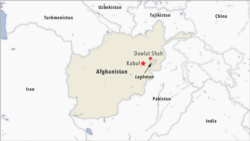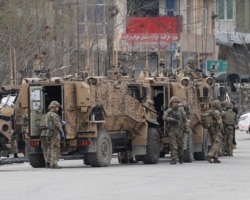Taliban insurgents have captured a district in eastern Afghanistan and negotiated a temporary truce with government forces in another, as U.S.-led foreign troops continue to withdraw from the country.
Separately, a roadside bomb blast early Thursday killed at least nine civilians, including women and children, in southern Helmand province.
Official sources and residents told VOA the Taliban entered the embattled Dawlat Shah district in Laghman province, after Afghan security forces retreated from their defense posts without offering any resistance.
The insurgents reportedly set a key government building and several surrounding security posts ablaze. The Afghan district had been under the Taliban siege for the last six months.
Taliban spokesman Zabihullah Mujahid claimed in a statement that it seized two tanks, a military vehicle, and “lots of weapons and ammunition” after Afghan police and soldiers “fled” the area.
The Afghan Defense Ministry said its forces had staged a "tactical retreat” but clashes were still raging in the area, inflicting “heavy casualties” on the insurgents.
Rare Truce
The fighting came a day after local elders in the adjacent Alishang district confirmed that Afghan forces and the Taliban had agreed to cease hostilities for a month to allow local farmers to harvest their wheat crops.
A copy of the truce, drafted by elders and shared via Taliban social media outlets, says it will also enable local students to take annual examinations. The ceasefire will last until June 21.
The rare truce followed several weeks of heavy fighting in Alishang, with the Taliban overrunning key Afghan forces’ outposts.
District residents have welcomed the rare ceasefire, though neither the Afghan government nor the insurgent group have confirmed the deal. The Taliban have also released an unspecified number of Afghan security personnel, said local elders.
Meanwhile, the Afghan Defense Ministry claimed Thursday national security forces had killed at least 178 Taliban fighters and wounded more than 100 others in operations underway across many provinces.
Both the Afghan adversaries often issue inflated casualty tolls for the opposing side, which are difficult to verify from independent sources.
'Real Choice' For Afghans
The fighting comes amid widespread concerns that Afghan forces will not be able to resist Taliban assaults for long once the United States and NATO forces completely pull out from Afghanistan by September 11.
The Afghan army and its air force have heavily relied on the U.S. for maintenance, training as well as for combat air support in battles against the Taliban.
Gen. Frank McKenzie, the commander of the U.S. Central Command said on Wednesday that he believes the Afghans have a “fighting chance” to be successful and defend themselves.
“It’s time for the Afghan military to stand up and show that they can fight alone,” McKenzie told reporters traveling with him to the Middle East. “I think it’s going to be a very taxing time for them. I think certainly there is a path for them to preserve what they have now. The risk is high. I don’t want to minimize that.”
However, U.S. special representative for Afghanistan reconciliation Zalmay Khalilzad dismissed those concerns in testimony before the House of Representatives Foreign Affairs committee in Washington.
“I personally believe that the statements that the [Afghan] forces will disintegrate and the Taliban will take over in short order are mistaken, Khalilzad said.
“The real choice that the Afghans will face is between a long war and a negotiated settlement and I hope the Taliban and the other Afghan leaders make the right choice,” stressed the U.S. envoy.
The last remaining approximately 2,500 American and roughly 7,000 NATO troops began withdrawing from Afghanistan May 1. The pullout has seen a sharp increase in Afghan fighting.
U.S. President Joe Biden announced the drawdown plan last month to wind down nearly 20 years of U.S. military engagement, describing it as America’s “forever war.”











